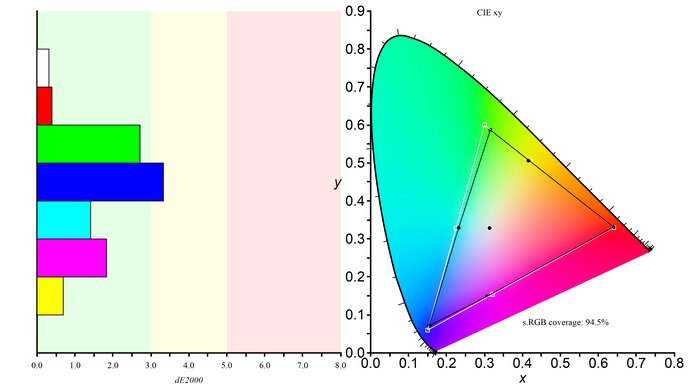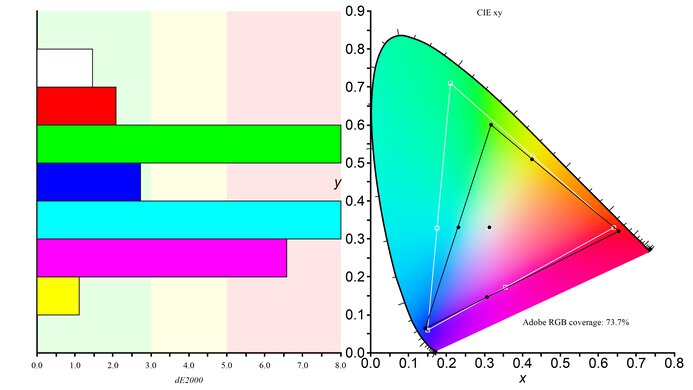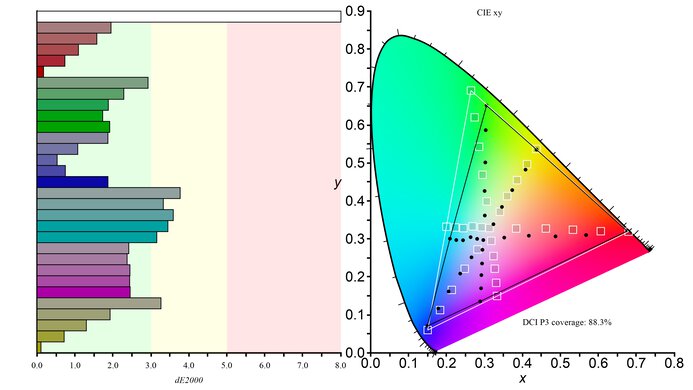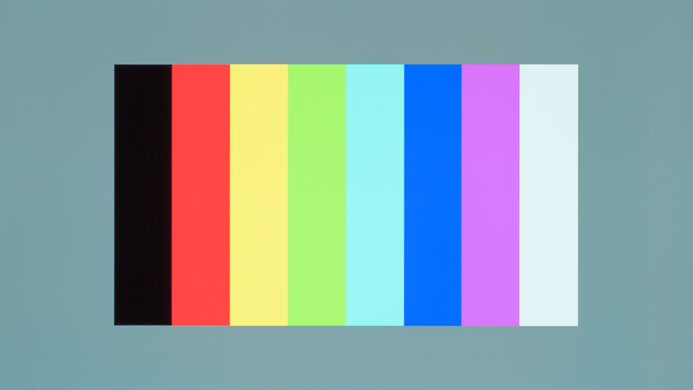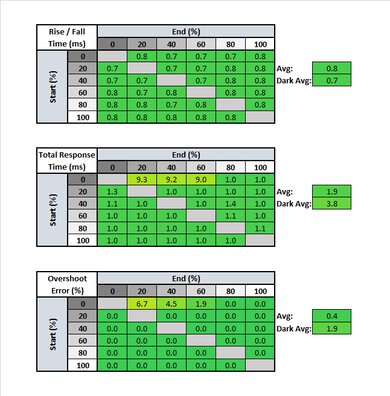We bought and tested the LG 48 CX OLED as a computer monitor, and even though this is meant to be a TV, it offers impressive overall performance as a monitor. Its 4k resolution delivers an exceptionally clear image, and its near-infinite contrast ratio allows it to produce inky blacks. It's an excellent choice for gaming because it has near-instantaneous response time, a 120Hz refresh rate, as well as native FreeSync variable refresh rate (VRR) support and G-SYNC compatibility. Although it has wide viewing angles, colors shift quickly when you move off-center. This makes images appear slightly inaccurate at the sides of the screen when sitting up close or when viewing from the side, so it isn't ideal for work that requires exact color reproduction. Sadly, it doesn't get very bright due to its aggressive automatic brightness limiter (ABL), but it does handle reflections extremely well. It's a really well-built TV with a sleek design, but unlike most monitors, its stand doesn't allow for any adjustments.
Like any OLED, it has the risk of permanent burn-in. This could be an issue with constant static displays like a computer's interface, but if you use a screensaver when you're not using it or if you also use it for watching varied content, you may avoid, or at least reduce, the risk.
Our Verdict
The LG 48 CX OLED is an impressive overall TV to use as a computer monitor. It's a great choice for any type of use, and it's excellent for gaming. It has a 120Hz refresh rate, native FreeSync support, and a near-instant response time. It has excellent viewing angles, great if you want to use it in an office setting or sit close to the screen. Sadly, the screen doesn't get bright enough to combat glare, but it has outstanding reflection handling. Lastly, it's a great choice for watching movies since it has an infinite contrast ratio.
Note: This isn't comparable to the 8.8 score the LG CX received in our TV review because of different scoring methods between monitors and TVs.
The LG 48 CX OLED is great for office use. It has a big 48 inch screen and a 4k resolution, great for opening multiple windows at once. Sadly, its stand doesn't allow for any type of adjustment and the screen doesn't get very bright. On the upside, it has outstanding reflection handling and extremely wide viewing angles.
Excellent choice for gaming. The LG 48 CX OLED has FreeSync VRR support and owners of NVIDIA graphics cards can take advantage of the G-SYNC compatibility. It has a 120Hz refresh rate, a near-instant response time, and a low input lag, although it's not as low as other monitors. It's an ideal choice for gaming in the dark as it's able to individually turn off pixels, producing perfect blacks.
Note: This isn't comparable to the 9.1 score the LG CX received in the TV review because of different scoring methods between monitors and TVs.
The LG 48 CX OLED is impressive for watching movies and videos. It has a high 4k resolution, it has an infinite contrast ratio and perfect black uniformity, and it handles reflections extremely well. It's also a great choice for watching videos with friends since it has very wide viewing angles. Lastly, it has a built-in smart operating system, so you get a ton of apps available to download without even turning on your PC.
Despite the high score, the LG 48 CX OLED isn't well-suited for content creation because colors shift quickly as you move off-center. This makes the image appear inaccurate at the sides when sitting up close and when viewing from the side. Also, it has limited coverage of the Adobe RGB color space used in photo editing. On the upside, it has a large high-resolution screen and a near-infinite contrast ratio to produce inky blacks.
The LG 48 CX OLED is an excellent choice for HDR gaming. It has native FreeSync VRR support, it's G-SYNC compatible, and it has a 120Hz refresh rate. The response time is near-instant and it has a low input lag. It supports both Dolby Vision and HDR10 and it displays a great wide color gamut for HDR content. It also gets bright enough to make small highlights pop in HDR the way they're supposed to.
Note: This isn't comparable to the 8.8 score the LG CX received in the TV review because of different scoring methods between monitors and TVs.
Changelog
- Updated Jul 05, 2021: Retested the VRR range, input lag, and SDR brightness; recalibrated it in Game Mode.
- Updated Feb 24, 2021: Retook the response time photo.
- Updated Jan 20, 2021: For consistency, we've changed the height adjustment from N/A to '0.0'. The score has been adjusted accordingly.
- Updated Dec 08, 2020: Retested input lag and HDR peak brightness.
Check Price
Differences Between Sizes And Variants
We tested the 48 inch LG CX OLED (OLED48CXPUB) and we expect our results to be valid for the 55 inch (OLED55CXPUA), 65 inch (OLED65CXPUA), and 77 inch (OLED77CXPUA) models.
If someone comes across a different type of panel or if their LG CX OLED doesn't correspond to our review, let us know and we'll update the review. Note that some tests such as the gray uniformity may vary between individual units.
| Size | US Model | Canada Model | EU Model |
| 48" | OLED48CXPUB | - | OLED48CX6LB |
| 55" | OLED55CXPUA | OLED55CXPUA | OLED55CX6LA |
| 65" | OLED65CXPUA | OLED65CXPUA | OLED65CX6LA |
| 77" | OLED77CXPUA | OLED77CXPUA | OLED77CX6LA |
The unit we reviewed was manufactured in June 2020, and you can see the label here.
Popular Monitor Comparisons
The LG 48 CX OLED delivers excellent overall picture quality, and even though it's a TV, it's a great choice to use as a PC monitor. Its replacement, the LG 48 C1 OLED, is nearly identical. Not many monitors on the market have an OLED screen like this, which displays perfect blacks and has wide viewing angles. Even though its input lag is higher than most monitors, it has an extremely quick response time. Regardless, if you're worried about the permanent burn-in risk, it's still better to get an LED monitor for much cheaper, like the LG 27UK650-W. Also see our recommendations for the best monitors for multimedia use, the best gaming monitors, the best 34-49 inch monitors, and the best TVs to use as PC monitors.
The LG 48 CX OLED and the LG C2 42 OLED are very similar. If you care about text clarity, the C2 is a better choice because it has a smaller screen with improved text clarity. Other than that, they're both very similar overall, but the C2 has a few more features.
The LG C1 48 OLED is the replacement to the LG 48 CX OLED, and both are very similar in performance. The C1 has lower input lag at 60Hz because of a new 'Prevent Input Delay' setting. The built-in webOS is updated, and it comes with a new Magic Remote. The CX scores higher for SDR peak brightness, but that's because we tested it with a different Picture Mode, and the C1 has about the same brightness in that Picture Mode.
Although the ASUS ROG Strix XG27UQ and the LG 48 CX OLED score similarly overall, they're very different types of displays. The ASUS is an IPS monitor with a slightly higher refresh rate, lower input lag, and higher peak brightness. It allows for ergonomic adjustments, which the LG doesn't offer, and its smaller screen results in a higher pixel density, so images and text look sharper. On the other hand, the LG has an OLED panel that can produce perfect blacks, making it better for dark rooms. It also has faster response time and supports HDMI 2.1. Although the LG has wider viewing angles, colors shift quickly when moving off-center, so it isn't ideal for content creation.
The LG 48 CX OLED is slightly better than the Gigabyte AORUS FO48U OLED. They have deliver nearly identical performance, but the LG is a bit brighter in HDR. The Gigabyte has slightly better viewing angles and a wider SDR color gamut, but this could be unit variance. The LG has a built-in smart interface and more advanced image processing options. The Gigabyte has better connectivity, though, as it has a DisplayPort connection and a built-in USB hub with a keyboard, video, and mouse switch.

We buy and test more than 30 monitors each year, with units that we buy completely on our own, without any cherry-picked units or samples. We put a lot into each unbiased, straight-to-the-point review, and there's a whole process from purchasing to publishing, involving multiple teams and people. We do more than just use the monitor for a week; we use specialized and custom tools to measure various aspects with objective data-based results. We also consider multiple factors before making any recommendations, including the monitor's cost, its performance against the competition, and whether or not it's easy to find.
Test Results

The LG 48 CX OLED has a premium design and because it's a TV, its stand is different than most monitors, allowing it to sit close to the table. It's made from both metal and plastic and it has a silver finish to it.
The front of the stand is metal and the back is plastic, and it supports the LG 48 CX OLED very well. The stand has a wide footprint, so you need a big table to place it on. It also sticks out a bit from the screen, so you may need some extra space in front to put your keyboard and mouse.
The back of the LG 48 CX OLED has a premium look to it. The top half is made from a textured metal, and the bottom half where the inputs are is solid plastic. It can be VESA-mounted, but you need to manually take off the stand as it doesn't have a quick-release button like some monitors. Lastly, cable management is done through the stand.
The LG 48 CX OLED doesn't have a local dimming feature since it doesn't have a backlight and can turn individual pixels off. Bright objects and subtitles are displayed perfectly.
Update 07/05/2021: We remeasured the SDR brightness in 'Game' Picture Mode because that's what we expect most people to use when using the TV as a monitor for low input lag. It's less bright than the 'Expert (Dark Room)' Picture Mode, but the ABL is less aggressive.
The LG 48 CX OLED has disappointing peak brightness, similar to most OLED TVs. This means that a white webpage or document isn't bright enough to combat glare. It doesn't get as bright as the LG CX OLED TV because we tested this in Game Mode with the input label set to 'PC', which is what we expect most people to have it in when using it as a monitor. If you want to use it for gaming or watching movies, you can use the other pictures modes, and the TV will be brighter.
We measured the peak brightness after calibration in the 'Game' Picture Mode with the input label set to 'PC', which disables some picture settings, including Peak Brightness. Outside of 'PC' mode in the 'Expert (Dark Room)' Picture Mode with Peak Brightness set to 'High', most scenes are between 248 to 343 cd/m², and we got 178 cd/m² in the 100% sustained window test and 273 cd/m² in a real scene. In the 'Expert (Dark Room)' Picture Mode with the input label set to 'PC', we measured a real scene brightness of 260 cd/m², with the 100% windows measuring about 160 cd/m², so it has a more aggressive ABL.
If you want the brightest image possible and don't care so much about image accuracy, we were able to 369 cd/m² in the 10% peak window test in 'Expert (Dark Room)' Picture Mode outside of 'PC' mode before calibration.
Update 12/08/2020: We measured the HDR peak brightness with Dynamic Tone Mapping enabled. It doesn't affect the screen brightness all that much, but enabling it increases the real scene peak brightness. However, we left the results as is because we normally test monitors without any sort of tone mapping setting enabled.
Decent HDR peak brightness. The LG 48 CX OLED gets bright enough to make small highlights pop in HDR. However, it quickly loses its brightness as larger, bright areas cover the screen due to the very aggressive ABL.
We measured the brightness with OLED Light at its max and Peak Brightness set to 'High' in 'Game HDR' Picture Mode, which is what we expect most people to use while using this as a PC monitor to get the lowest input lag possible. We got the brightest image possible with these settings as seen in the 2% peak window test. The 'Cinema' Picture Mode has a higher peak brightness, as seen in the TV review.
Like most OLED TVs, the LG 48 CX OLED has very wide horizontal viewing angles. However, colors shift quickly when moving off-center. This makes the colors appear inaccurate at the sides when sitting up close and when viewing from the side, which isn't ideal for content creation.
The LG 48 CX OLED has an outstanding vertical viewing angle, which is expected from an OLED TV. The image remains accurate even if you sit close to the screen.
The LG 48 CX OLED has remarkable gray uniformity. There aren't many visible uniformity issues throughout, and in near-dark scenes, there's some minor vertical banding, which is common with OLED displays. The gray uniformity is better than the LG CX OLED TV we reviewed, but this is something that varies between units.
The LG 48 CX OLED has mediocre out-of-the-box color accuracy. Most colors are slightly inaccurate and the color temperature is warm, giving the image a red/yellow tint. White balance is off, which affects the shades of gray, and gamma doesn't follow the target curve well, so most scenes are too dark, except for really bright scenes, which are over-brightened. We measured this in the 'Expert (Dark Room)' Picture Mode with the input label set to 'PC'.
Note that the LG CX OLED has a much higher color accuracy before calibration, and this is partially due to the different color targets in testing between monitors and TVs. Color temperature is also different between this 48 inch model and the 55 inch TV we tested, but this can vary between units.
Update 07/05/2021: We calibrated the TV in the 'Game' Picture Mode because we expect most people to be using this mode when connected to a PC to get low input lag. The ICC profile has also been updated.
The LG 48 CX OLED has fantastic color accuracy after calibration. Any remaining inaccuracies aren't visible without the aid of a colorimeter, and gamma follows the curve much better, except bright scenes are still slightly over-brightened. We measured this in the 'Game' Picture Mode with the input label set to 'PC'.
You can download our ICC profile calibration here. This is provided for reference only and shouldn't be used, as the calibration values vary per individual unit even for the same model due to manufacturing tolerances.
The LG 48 CX OLED has an impressive SDR color gamut, but not as good as most monitors. It covers almost all of the sRGB color space used in most content, but it has limited coverage of the Adobe RGB color space used in photo editing. We measured this in the 'Expert (Dark Room)' Picture Mode with the input label set to 'PC'.
The LG 48 CX OLED has an excellent SDR color volume. It displays dark, saturated colors really well due to its infinite contrast ratio. We measured this in the 'Expert (Dark Room)' Picture Mode with the input label set to 'PC'.
Very good HDR color gamut. The LG 48 CX OLED has excellent coverage of the commonly-used DCI P3 color space, but the coverage of the Rec. 2020 color space is more limited. We measured this in the 'Game HDR' Picture Mode with the input label set to 'PC'.
Note that this TV appears to have less coverage of the DCI P3 color space compared to the 55 inch LG CX OLED we tested on our TV test bench. This is due to the way we calculate DCI P3 coverage. On TVs, we estimate the DCI P3 coverage based on the Rec. 2020 measurements, but on Monitors, we measure the actual coverage. The 68.5% Rec. 2020 measurement we took on the 48" CX corresponds to a 97% DCI P3 coverage if calculated as a TV, which is also what we calculated on the 55" CX.
Decent HDR color volume. Once again, the LG 48 CX OLED displays deep colors well, but it struggles to display a wide range of colors at different luminance levels. We measured this in the 'Game HDR' Picture Mode with the input label set to 'PC'.
Unlike the LG CX OLED, the LG 48 CX OLED has some image retention, even 10 minutes after displaying a high-contrast test image. We didn't experience any temporary image retention with the 55 inch we tested in the TV review, but this could vary between units.
Note that this is different from the permanent burn-in OLED TVs may experience. Read more about the long-term burn-in risk here.
The LG 48 CX OLED has remarkable gradient handling. There's some banding in dark red, green, and gray, but this shouldn't be noticeable with most content. We measured this in the 'Expert (Dark Room)' Picture Mode with the input label set to 'PC'.
Note that this scores higher than the 8.6 in the TV review because the gradient score is subjectively assigned in monitors.
Update 09/22/2020: We received reports of people noticing vertical red lines appearing when displaying yellow or green. We recreated this issue and updated the text; see below for details.
The LG 48 CX OLED has decent text clarity. Since this TV uses a WBGR sub-pixel layout with four sub-pixels, all four are never turned on at the same time, and you can see the alternative pixel photo here. Only the blue and white pixels are turned on with a white background, as seen here, which affects the way text is displayed. Enabling ClearType (top photo) slightly improves the clarity on the diagonal lines of the letters R and N, but at 100% scaling, it might still be difficult for some to see text. Below is a list of text clarity photos at 125, 150, and 300% scaling with and without ClearType enabled.
| Scaling | ClearType On | ClearType Off |
| 100% | ClearType On | ClearType Off |
| 125% | ClearType On | ClearType Off |
| 150% | ClearType On | ClearType Off |
| 300% | ClearType On | ClearType Off |
Although Windows recommends to use 300% scaling on a PC, text is just way too big to be used by most people.
We received reports of the TV displaying vertical red lines when there are solid areas of yellow and green. This happens when the TV is in 'PC' mode and displaying chroma 4:4:4. Even though putting it out of 'PC' mode to display 4:2:2 helps reduce the issue, it makes text more blurry. We still recommend leaving the TV in 'PC' mode to get clear text, but you may notice these red lines. You can see the photo here.
| Overdrive Setting | Response Time Chart | Response Time Tables | Motion Blur Photo |
| No Overdrive | Chart | Table | Photo |
Update 02/24/2021: We retook the response time photo because our original picture looked blurry.
Like most OLED TVs, the LG 48 CX OLED has a near-instant response time. There's some overshoot in the darker transitions, but this shouldn't cause too many artifacts. Unlike most monitors, there isn't any overdrive setting. Note that we needed to put the TV in chroma 4:2:0 subsampling to achieve 4k at 120Hz, due to technological limitations.
We measured this in the 'Game' Picture Mode with the input label set to 'PC', and the pictures are taken in the 'Expert (Dark Room) Picture Mode. Since OLED TVs have a near-instant response time, we don't expect the picture mode to change the response time.
Even though this scores the same as the LG CX OLED TV review, the measurements aren't comparable between monitors and TVs. We calculate the response time and overshoot in different ways between the two.
| Overdrive Setting | Response Time Chart | Response Time Tables | Motion Blur Photo |
| No Overdrive | Chart | Table | Photo |
The LG 48 CX OLED has an incredible response time at 60Hz. There's only some minor overshoot in the darker transitions again, but this doesn't cause much motion blur. Like with the response time at its max refresh rate, the measurements are taken in the 'Game' Picture Mode with the input label set to 'PC', but the pictures are from the 'Expert (Dark Room)' Picture Mode.
The LG 48 CX OLED doesn't use Pulse Width Modulation (PWM), but there's a slight dip in brightness every 8 ms, which coincides with the 120Hz refresh rate. Most people shouldn't notice this. Note that the scaling of the graph isn't the same as the graph in the TV review, so although it may seem there's more flicker on this unit, it's the same between the 48 inch and 55 inch units we reviewed.
The LG 48 CX OLED has a black frame insertion (BFI) feature to improve the appearance of motion. We measured this in the 'Expert (Dark Room)' Picture Mode with the input label set to 'PC' and TruMotion set to 'High'.
Update 07/05/2021: We updated the TV to the latest firmware and retested the VRR range. It goes as low as 20Hz, which matches the LG 48 C1 OLED.
The LG 48 CX OLED has an excellent refresh rate of 120Hz. It has native FreeSync VRR support, which helps reduce screen tearing. It's certified by NVIDIA to be G-SYNC compatible, and unlike most G-SYNC compatible monitors, such as the LG 34GN850-B, G-SYNC works over an HDMI connection.
Update 07/05/2021: We updated the TV to firmware 3.23.06 and retested the input lag. The update improved the input lag, and it's similar to the LG 48 C1 OLED. We also removed the 10-bit HDR input lag measurement because we don't have the tools necessary to measure it with a 4k resolution and 120Hz refresh rate over HDMI. That said, we don't expect the HDR input lag to significantly increase.
Update 12/08/2020: We updated the TV to firmware 03.11.30 and retested the input lag at its max resolution of 4k @ 120Hz. This decreased the input lag because it was originally measured at 4k @ 60Hz.
The LG 48 CX OLED has outstanding low input lag. It increases at 60Hz, but most people shouldn't notice the difference. We measured this in 'Game' mode with the input label set to 'PC', which are the settings required to achieve the lowest input lag possible. Outside of 'Game' mode in the 'Expert (Dark Room)' Picture Mode with the input lag set to 'PC', we measured an input lag of 15.2 ms at 4k @ 120Hz.
Note that this score isn't comparable to the 8.8 score the LG CX OLED received in the TV review because of the different way we score input lag in TV and monitor reviews. However, the individual results are comparable between the two because we measure input lag the same way.
Find out more about the TV's recommended PC settings here.
The LG 48 CX OLED has an excellent resolution and size if you're going to use it as a monitor. The 4k resolution delivers an exceptionally clear image, but due to the screen's size, the pixel density isn't as high as the LG 27UK650-W. Note that the pixel density also decreases if you get a bigger variant, but if you want an OLED with a smaller screen, then check out the LG 42 C2 OLED.
Being a TV, the LG 48 CX OLED has a great selection of inputs including a Composite In (adapter included), a Tuner, and an Ethernet port. It doesn't have a DisplayPort input, which is something most monitors have and TVs don't.
See the LG CX OLED TV review for the full list of input specifications and audio passthroughs. If you're looking for something similar with more traditional monitor inputs like DisplayPort, then check out the Gigabyte AORUS FO48U OLED.
The LG 48 CX OLED has a ton of extra features compared to other monitors, such as a built-in smart operating system. There's a great selection of apps available to download on LG's WebOS, so you don't have to turn on your PC to stream content. There are also built-in speakers, and it has other features like motion interpolation and the ability to remove judder, which most monitors don't have.
There's a single button underneath the center of the screen. It allows you to turn the TV on/off, change inputs, volume, and channels. Note that unlike most monitors, the LG 48 CX OLED doesn't turn off or go in standby mode when your computer is shut down or goes to sleep, so you'll need access to either the power button, or the remote.
























